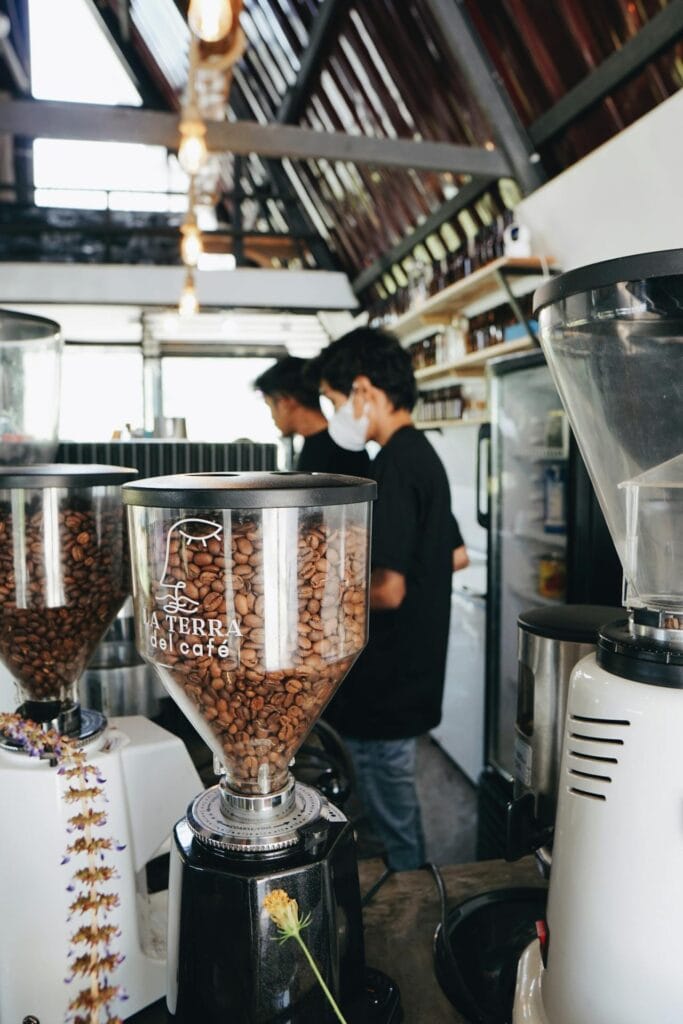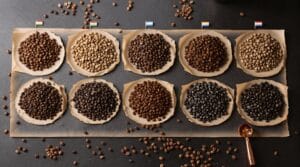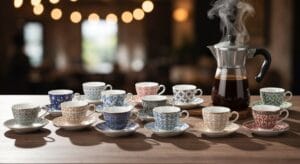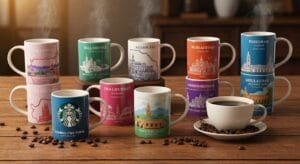You might assume dark roast delivers that hard-hitting caffeine kick solely based on its bolder flavor. Contrary to popular belief, measuring by volume – like the scoop going into your brewer – blonde roast actually packs more caffeine. Its shorter roasting time preserves bean density, meaning you fit far more potent beans into that scoop than their larger, expanded dark roast cousins. It’s the bean density, not the flavor intensity, crafting that stark difference.
Comparing Caffeine: Blonde Roast vs. Dark Roast
While you might expect darker roasts to pack more caffeine due to their bolder flavor, blonde roast coffee slightly edges out dark roast in caffeine content when measured by volume. This happens because blonde roast coffee beans are denser after shorter roasting. So, when you scoop beans for brewing, you get more actual coffee – and thus more caffeine – in that blonde roast scoop. Dark roast beans expand and lose mass, yielding less dense grounds per scoop. This results in an average caffeine concentration difference of about 60mg per ounce for blonde roast compared to 51mg for dark roast during typical home brewing. The difference in caffeine concentration also reflects variations in bean density and roast level, which impact the caffeine extraction during brewing. Espresso typically requires a medium to dark roast to optimize flavor balance and extraction quality. Roasting doesn’t alter caffeine in the beans significantly. An 8-ounce serving of blonde roast coffee caffeine averages around 95mg, often exceeding dark roast like Starbucks Blonde (180mg vs Dark at 130mg). Brewing technique, grind size, and using Arabica instead of higher-caffeine Robusta also impact your cup’s caffeine more than roast. Though dark roast tastes stronger, that flavor doesn’t signal higher caffeine from the blonde roast coffee.
Roasting’s Role: Degradation and Bean Density

Roasting transforms coffee beans through heat application, directly impacting their chemical composition and physical properties. Heat exposure during roasting causes caffeine molecules to partially degrade; longer roasting times lead to greater caffeine breakdown. Blonde roast coffee, roasted for the shortest duration (typically stopping just after the first crack), minimizes this degradation compared to darker roasts. This contributes to light roast coffee typically retaining more caffeine than darker roasts. Simultaneously, heat makes beans expand and lose moisture, significantly reducing their density. Darker roasts become much less dense. However, your light roast coffee retains more moisture, resulting in a higher density per bean. This greater density means that when you measure coffee by volume (like using a scoop), denser light roast coffee beans pack more mass – and thus more caffeine – into that scoop than less dense dark roast beans. The roasting process also initiates complex chemical reactions such as Maillard reactions and sugar caramelization that define the final flavor profile alongside these physical changes. The first crack stage marks a critical turning point in roasting where beans reach a temperature around 196°C to 205°C, signaling important chemical transformations that influence caffeine preservation and bean density.
Why Flavor Strength Doesn’t Signal Higher Caffeine
Your taste buds might detect dark roast’s bold smokiness as “stronger,” but that punchy flavor doesn’t mean it packs more caffeine per cup. This is a classic case where your perception of flavor strength misleads you about the actual caffeine content. Roasting deepens those robust, often bitter notes by transforming flavor compounds, not by boosting caffeine levels. Coffee loses water weight during roasting, slightly concentrating caffeine *by weight* in dark beans, yet those beans expand. dark beans become light and puffy. Measured *by volume* (like a scoop), denser blonde roast beans deliver more coffee mass and thus more caffeine per scoop. Very dark roasts offer intense taste, but blonde brews often edge them out in actual caffeine per measured cup. Light roasts consistently provide the highest caffeine per volume.
Caffeine Influencers: Beyond Roast Level
Considering your blender grind size or pour-over technique, you’d naturally assume the roast level exclusively sets caffeine content—it doesn’t.
While Starbucks blonde roast generally carries slightly more caffeine per brewed ounce than dark roast when measured by volume, other critical factors dominate. Caffeine molecules themselves aren’t destroyed, resulting in only minor caffeine differences across roasts despite significant mass loss during roasting.
The coffee bean species reigns supreme: a hefty dose of caffeine naturally resides in Robusta beans compared to Arabica. Robusta beans have about 182 mg of caffeine per 100 g of green beans, significantly higher than Arabicacaffeine content. This high caffeine concentration also contributes to Robusta’s natural pest resistance and its robust growing profile.resilience and pest resistance
Additionally, while roasting drives off water weight causing darker beans to become less dense than lighter ones, it actually increases the final caffeine concentration percentage in the roasted coffee mass itself.
Your choice between espresso machine and French press matters heavily due to differences in brewing time and pressure. French press brewing uses a direct immersion method that promotes uniform extraction and can influence caffeine yield depending on the total time and grind size used.
Grind size dramatically increases the extraction surface area, pulling out more caffeine.
Serving size directly dictates your total caffeine intake; a large iced coffee packs more than a small.
Profile of a Cup: Caffeine and Nutrition
Blonde roast coffee packs about 95 milligrams of caffeine per standard 8-ounce hot cup, slightly edging out dark roast’s typical 85 milligrams. Comparatively, espresso drinks like lattes often contain lower caffeine than brewed counterparts despite appearing stronger. Understanding what’s blonde roast coffee helps explain this: it’s a light-roasted coffee where the beans spend less time under heat, minimizing caffeine loss compared to darker roasts processed longer.
When you prefer it black, a cup offers nearly zero calories and negligible fat, carbs, or protein. This minimal count falls far below the 25-calorie baseline typical for many 12 fl oz beverages.
However, adding milk, syrup, or sweeteners significantly increases the caloric intake.
You get higher caffeine concentrations in larger servings – a Starbucks 12-ounce blonde has around 180 mg caffeine, escalating substantially in bigger venti cups.
While its caffeine lead over dark roast is modest, that edge combined with its lighter nutritional footprint defines its profile.
Conclusion
Don’t assume that milder blonde roast means less kick. It’s actually the opposite volume-wise! Those lightly roasted beans stay denser and pack more caffeine per scoop than expanded dark beans. Flavor intensity isn’t a caffeine clue here. While origin and brewing tweak the jolt, the blonde roast’s hidden density gives it a surprising caffeine edge for your cup. Brew based on taste, not buzz myths.
References
- https://www.starbucks.ca/menu/product/873068625/hot/nutrition
- https://www.pepsicoproductfacts.com/Home/Product?formula=Star*Iced*LR_13&form=RTD&size=48
- https://www.starbucks.com/menu/product/873068654/hot/nutrition
- https://qualitexglobal.com/what-is-blonde-roast-coffee/
- https://cornercoffeestore.com/caffeine-in-blonde-roast-vs-dark-roast-coffee/
- https://kickinghorsecoffee.com/pages/which-roast-has-more-caffeine
- https://blackcreekcoffee.com/blogs/coffee-talk/which-coffee-has-more-caffeine-dark-or-light-roast
- https://www.healthline.com/nutrition/light-vs-dark-roast-coffee
- https://colipsecoffee.com/blogs/coffee/blonde-roast-coffee
- https://cafely.com/blogs/info/blonde-roast-coffee





